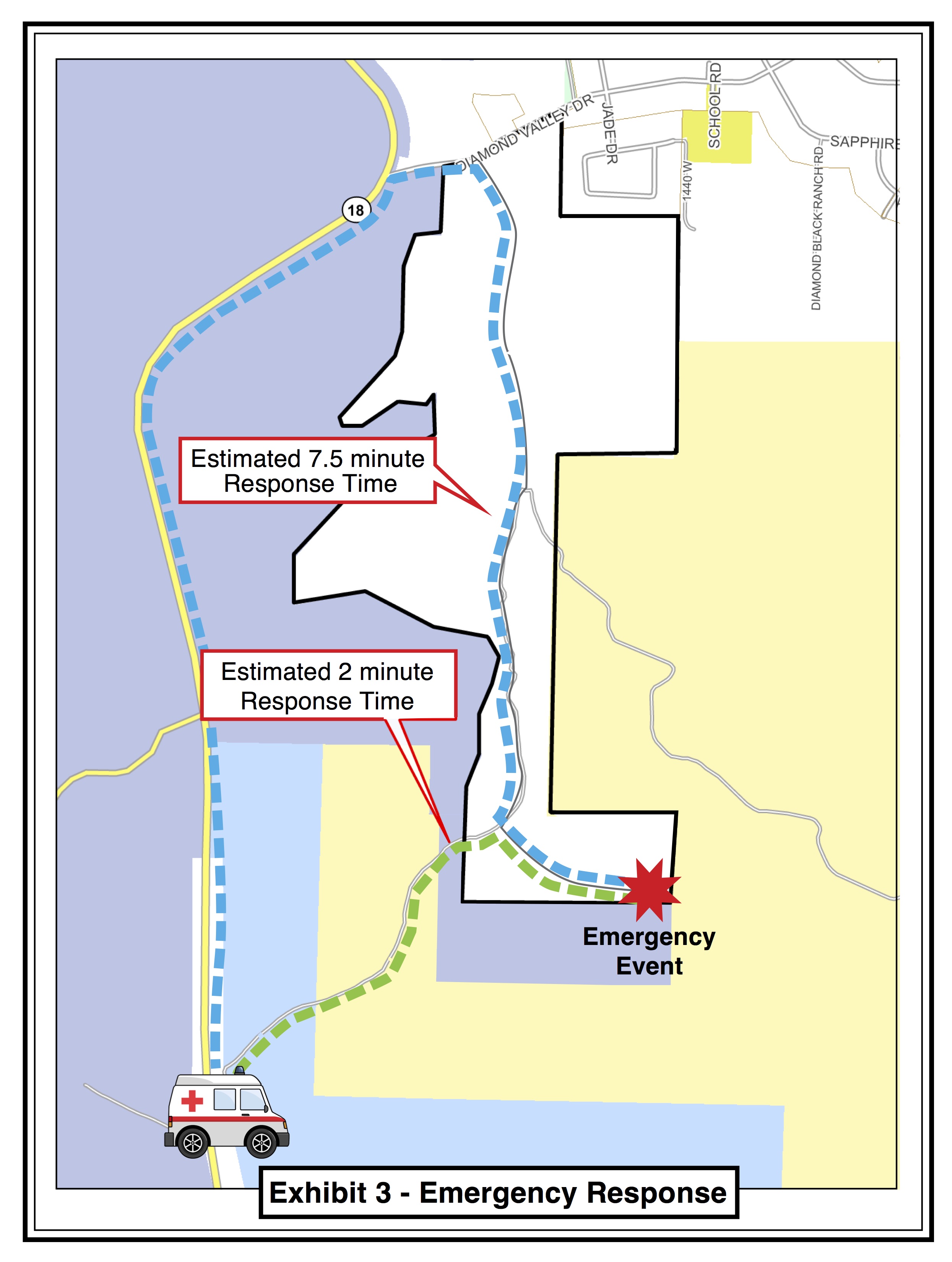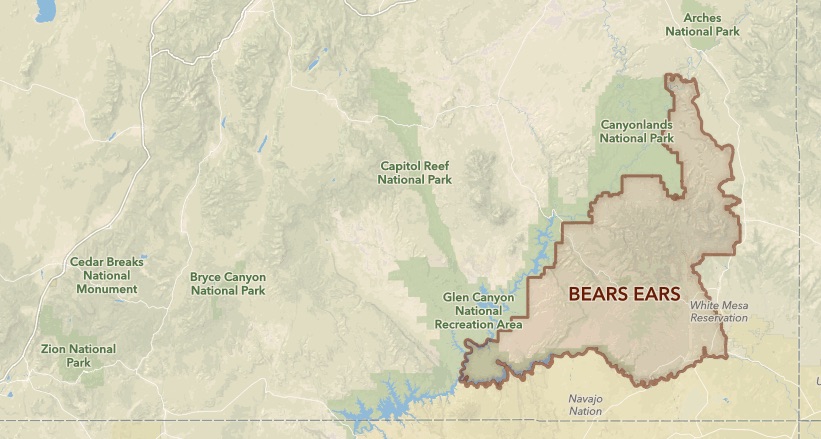
ST. GEORGE – Washington County commissioners came out in support Tuesday of a short roadway through protected desert tortoise habitat that would allow a developer to build a 410-acre development near the north entrance of Snow Canyon State Park. However, they passed a resolution opposing the Bears Ears monument designation.

The proposed development commissioners supported, CoaChella at Snow Canyon, would be built on land owned by developer Kirk Willey and located east and south of the Diamond Valley Cinder Cone and east of state Route 18.
Developing the property would require a 2,158-foot road – approximately 0.4 miles – to be built across a dangling corner of the Red Cliffs Desert Reserve to connect Willey’s property to SR-18 (see map).
The development currently has an access on West Diamond Valley Road on the north end of the property. However, to meet fire codes for emergency vehicle access, it needs a second road.
“Really, the only opportunity for that second access point is the section of the existing R.S. 2477 road, where I’ve applied for a right-of-way,” Willey told the commission at Tuesday’s meeting.
R.S. 2477 roads and rights-of-way cross federal land but are claimed by individual counties in a long-running court battle that has been underway since 1987.
Read more: Backroad access: County seeks witnesses to help keep historic roads open
The proposed roadway crosses land controlled by four agencies, three of which support the proposal. Utah Department of Transportation, Utah State Institutional Trust Land Administration and Snow Canyon State Park are all supportive of the road, Willey said. However, the road must also be approved by the Habitat Conservation Advisory Committee, which oversees the Red Cliffs Desert Reserve and the threatened Mohave desert tortoise.

Willey said he has been working with the advisory committee and the federal agencies that are involved for over a year. To get the road approved, he must offer a 5-1 mitigation; because the proposed road will remove about four acres from the reserve, he must provide approximately 20 acres of additional habitat.
“Which I am able and willing and have provided a plan to do,” Willey said.
“I consider myself to be an environmentalist,” Willey told the commission, adding that he fully supports the reserve but feels that humans have a place in Washington County as well.
The original Habitat Conservation Plan allowed for “reasonable access and right-of-ways,” he said.
Deputy Washington County Attorney Eric Clarke said the HCP also allows for upgrading existing right-of-ways; the county has claimed the roadway in the R.S. 2477 lawsuit.
The development site is not particularly good tortoise habitat, Willey said. At 4,100 feet at its lowest point, it is higher than what is considered good habitat. Proposed mitigation property near Leeds is much lower and potentially better habitat.
From the perspective of the advisory committee, the issue is whether the proposed mitigation is a net benefit to the desert tortoise. A new paved road is not allowed under the current HCP agreement and would require an amendment to the document.
Read more: 410-acre development would require road through protected tortoise reserve
Plans for the CoaChella development include natural landscaping, single story residences, low roof-lines and minimal fencing. Plans call for 600-800 homes placed on lots averaging .4 acres, with green space and 10 miles of trails. A clubhouse, tennis and pickleball courts and a swimming pool complex are also planned.
The development is expected to be built in phases over the next 15-20 years. Most of the development will take place in a valley hidden from view of SR-18 by bluffs, rock formations and the cinder cone, Willey said.
The commission passed a resolution supporting the proposed road; however, the advisory committee has the final say in the matter. The commission is not approving a subdivision at this point, Commissioner Victor Iverson said; the development would have to go through the normal county approval process.
Bears Ears
The County Commission passed a resolution opposing the designation of the proposed 1.9 million-acre Bears Ears National Monument in San Juan County in southeast Utah, calling it a land grab being pushed by environmental groups and nonlocal Native Americans.

The proposal for the monument designation states that Bears Ears would be collaboratively managed by federal agencies and Native American tribes, without any input from local governments.
However, Commissioner Iverson said, collaborative management should always involve local government. All of the Native American cultural sites in the 1.9 million acres are currently protected under federal law, and national monument designations are bad land management policy actions, Iverson said.
“It’s really bad management policy on the ground, is the way it works out. It ends up not protecting what they claim they want to protect, and it ends up hurting local communities, as well,” Iverson said.
Commissioner Alan Gardner said he has attended two separate hearings in San Juan County, and the monument designation is opposed by almost everyone there, including local Native Americans.
“It’s not supported by hardly anyone in the county, including Native Americans there,” Gardner said. “It’s all people from outside the county that are promoting it.”
Other business
In other business, the commission appointed five members to staggered terms on the administrative control board of the newly created Diamond Valley Fire Special Service District. Two of the board members’ terms will run through 2017, and three will end in 2019, preventing all the terms from expiring simultaneously. Because it is a new district, positions are appointed; subsequent terms will be filled by election.
“We had just enough applicants (to fill the positions), so we appreciate those who were willing to step up,” Iverson said, laughing.
The action is part of a friendly separation of the Southwestern Special Service District into two entities and creating separate fire districts for Diamond Valley and Winchester Hills.
Email: [email protected]
Twitter: @STGnews
Copyright St. George News, SaintGeorgeUtah.com LLC, 2016, all rights reserved.
anyone surprised?
i’m sure they support the pipeline also
you know i don’t even find the pipe in itself that offensive. it’s the way they plan to pay for it thats offensive
The only thing offensive here is you !
Of course they want this. Why do you think they want Prop. 1 to pass? That road isn’t going to pay for itself. You are dear residents.
Oh, you may say the developer is going to pay for it. Do you really think that? If you do, I have a bridge just before the Ledges off ramp just waiting to be built, that I’ll sell you.
The road gets approved.
The developer builds it.
If he pays for it, the buyers of the homes, OR the rest of the residents pay for it in taxes.
Then the area “grows”.
The pipeline gets approved to provide water to these homes.
Then more wealthy people come to buy the homes.
Then the illegals come to build the homes, A(cheap labor).
Then the crime rate skyrockets.
The traffic skyrockets.
The noise is unbearable.
The developer/contractor related commissioners get the $$$$.
Get the picture yet???
VOTE NO ON PROP. 1!
NO NEW TAXES!
NO MORE GROWTH!
And the growth and money machine roll on. And the quality if life and air decrease!